| |
|
24.
 | Between the lines
| Between the lines |
| |

'' In Between the lines, a steel circular saw blade becomes the inscription surface for Koran verses, which undergo a process of being emptied of semiotic content
and rendered decorative elements. The defining qualities of both the object and of language are suspended,
and the image becomes the new bearer of knowledge. ''
Elena Stanciu, PETRIe Magazine, 2016
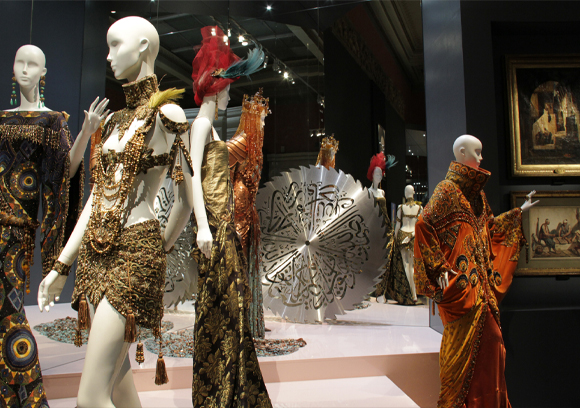
Between the lines
Exhibition view from Inspiration Dior, Musée des Beaux Arts Pouchkine, 2011, Moscow.
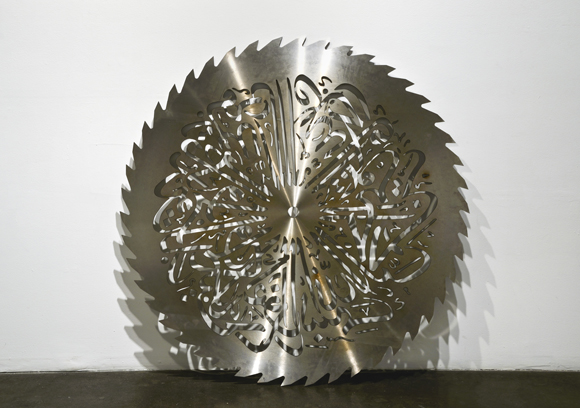
Between the lines
Exhibition view from Kissing Circles, Shoshana Wayne Gallery, 2012, Santa Monica.
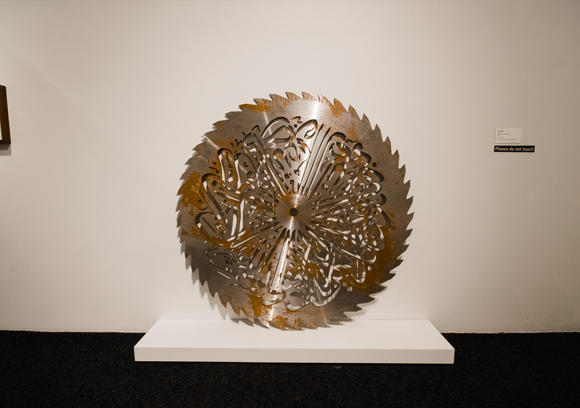
Between the lines
Exhibition view from Cut up/Cut out, Bellevue Arts Museum, 2017, Bellevue.
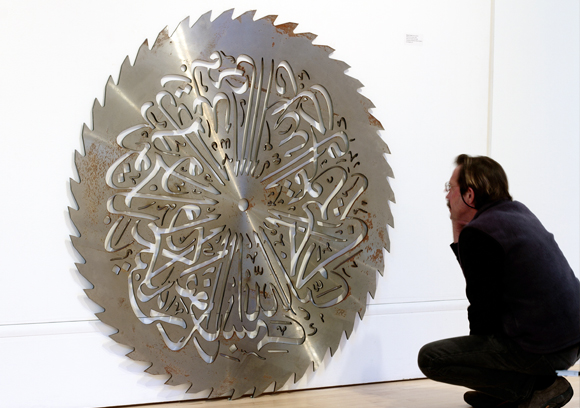
Between the lines
Exhibition view from Cut up/Cut out, Bedford Gallery, 2016, Walnut Creek.
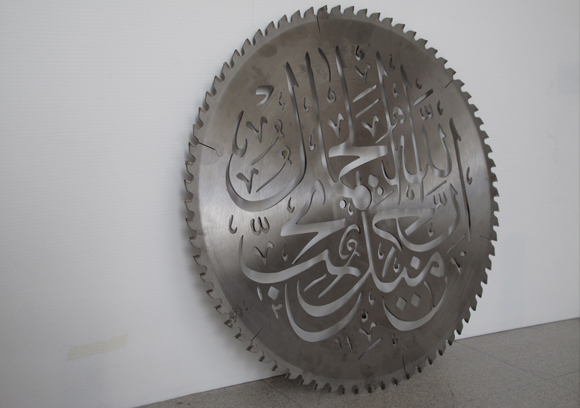
Between the lines
Exhibition view from Art Brussels, Galerie Conrads, 2010, Brussels.
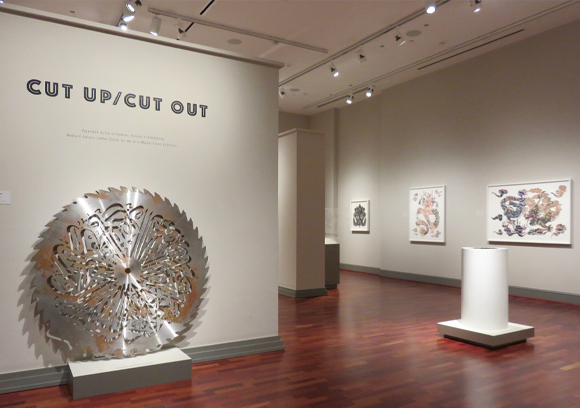
Between the lines
Exhibition view from Cut up/Cut out, Huntsville Museum of Art, 2017, Huntsville.
|
|
2010, saw blade in steel, 150 cm.
Exhibition view from The Storyteller, Art Gallery of Ontario, 2010, Toronto.
Courtesy of the artist and Shoshana Wayne Gallery, Santa Monica.
Ed. of 5 + 1 A.P.
|
|
|
| Collection of AGO, Art Gallery of Ontario, Toronto
Collection of Bank Al-Maghrib, Casablanca
Lame de scie circulaire aux dimensions impressionnantes et aux grandes dents acérées, Entre les Lignes s'ornemente à sa surface de motifs calligraphiques en arabe classique découpés avec précision dans un acier poli aux reflets étincelants. Les écritures stylisées renvoient à la sourate 112 du Coran, intitulée "Al-Ilkhlas" ("La Purification"), qui affirme la transcendance de Dieu (Al-Tawhid) et évoque également son témoignage par le croyant : " Dis : «Lui , Allah, l'Unique / Allah, le Numineux / Il n'enfante pas et n'est pas enfanté / Il n'a pas d'égal ! » "
Entre les Lignes interroge les notions mystiques ou religieuses d'unité et d'unicité de dieu : l'œuvre étudie la signification de ces tawhids (ou dogmes), observe leur fonctionnement et évoque leurs effets. Plus largement, et dans une démarche similaire à celles du Paradoxe (2013), des Temps Modernes (2010) ou du Jour du Réveil (2011), installations et sculptures recourant également aux lames circulaires et aux inscriptions calligraphiées découpées dans le métal, Entre les Ligne explore les rapports du langage à la religion et à la pensée critique. L'expression qui désigne l'œuvre, dotée de sens littéraux et figurés, semble solliciter les capacités cognitives et linguistiques du spectateur. Elle l'invite à lire "entre les lignes", à deviner des significations qui ne seraient pas explicitement formulées.
L'objet détourné par l'artiste se dédouble. A la fois outil et objet d'art, elle suggère d'autres dédoublements, oppositions ou ambivalences : l'outil est à la fois instrument de construction et de destruction ; l'élégance légère des motifs calligraphiques contraste avec la puissance brutale de l'outil. On ne doute pas qu'un outil d'une telle dimension, faisant à l'évidence partie d'une machinerie linguistique possédant ses beautés et subtilités propres, n'aie pas la puissance suffisante pour fonder des civilisations et des croyances, ou au contraire en anéantir d'autres. L'unité et l'unicité sont des concepts qui rassemblent autant qu'ils divisent et séparent ; les cultures comme les individus. Et cependant cet instrument, si terrible soit-il, est lui-même la proie du temps qui passe et la surface métallique se couvre lentement des traces d'oxydation, comme autant de signes d'une écriture sans cesse changeante et qui, lentement mais inexorablement, modifie l'ensemble.
Quant à la notion de purification, si son application en chimie est utile par exemple, elle a souvent pris des résonances inquiétantes, voire tragiques dans l'histoire des religions et des peuples de ces derniers siècles. L'attrait esthétique de l'œuvre est finalement impossible à dissocier d'une impression de dangerosité. Mounir Fatmi élabore avec Entre les Lignes un de ses pièges esthétiques à la séduction essentiellement ambigüe, qui vient ici révéler le rôle ambivalent du langage et met en garde contre ses séductions aussi belles que dangereuses. L'œuvre incite le spectateur à une approche philologique et critique du langage qui tient compte de son historicité, évite toute posture dogmatique et ne se limite pas au premier degré de lecture, ou à un quelconque sens littéral.
Studio Fatmi, Mars 2017.
|
|
A circular saw blade of impressive dimensions with large sharp teeth, Between the Lines is decorated on its surface with calligraphic motifs of classical Arabic writing, cut with precision out of polished steel with gleaming reflections. The stylized writing refers to surah 112 of the Koran, entitled "Al-Ilkhlas" (“The Purification”), which affirms the transcendence of God (Al-Tawhid) and evokes the testimony of the believer: “Say: ‘He, Allah, the only one / Allah the luminous / He bears no child and is not born / He has no equal!’”
Between the Lines questions the mystical or religious notions of the unity and uniqueness of god: the work studies the meaning of these tawhids or dogmas, observes the way they function and evokes their effects. More broadly, and following a similar approach to that of Paradox (2013), The Modern Times (2010) or The Day of Awakening (2011), different installations and sculptures that also resort to circular blades and calligraphic writing cut out of metal, Between the Lines explores the relation between language, religion and critical thought. The expression designating the piece, with both its literal and figurative meanings, seems to call upon the viewer’s cognitive and linguistic capacities. It beckons him to read “between the lines”, to guess significations that are not formulated in an explicit way.
Twisted by the artist, the object is split into two different things, both tool and work of art, it suggests other splits, oppositions and ambivalences: the tool is an instrument of both construction and destruction; the airy elegance of the calligraphic motifs contrasts with the machine’s brutal power. One cannot doubt that a tool of such dimensions, evidently part of a linguistic machinery possessing its own beauties and subtleties, doesn’t have sufficient power to found civilizations and beliefs, or on the contrary to destroy others. Unity and uniqueness are concepts that can bring together cultures and individuals as much as they can divide and separate them. Nevertheless, this instrument, mighty as it may be, is subject to the passage of time, its metallic surface progressively covered with traces of oxidization, like signs of an ever changing writing, slowly but surely altering the entire thing.
As for the notion of purification, if its application is useful in the field of chemistry for example, it has often had worrying or even tragic connotations in the history of religions and peoples over the last centuries. In the end, the aesthetic appeal of the work is impossible to dissociate from an impression of dangerousness. Mounir Fatmi creates with Between the Lines one of his aesthetic pitfalls with an essentially ambiguous seduction that reveals the ambivalent role of language and sends out a warning against its beautiful yet dangerous seductiveness. This piece encourages the viewer to a philological and critical approach of language that takes into account its historicity, steers clear of any dogmatic posture and doesn’t limit itself to the first degree of interpretation or to a literal signification.???
Studio Fatmi, March 2017.
|
|
|
|